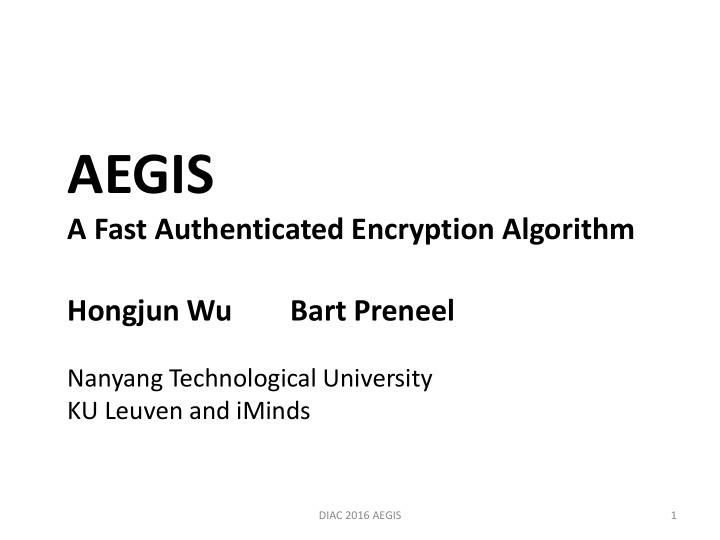



AEGIS A Fast Authenticated Encryption Algorithm Hongjun Wu Bart Preneel Nanyang Technological University KU Leuven and iMinds DIAC 2016 AEGIS 1
AEGIS: A shield carried by Athena and Zeus DIAC 2016 AEGIS 2
Different Design Approaches: AES-NI ( AEGIS ) Fast SIMD (MORUS) Mode (JAMBU) Lightweight Dedicated (ACORN) DIAC 2016 AEGIS 3
No tweak for the second and third rounds DIAC 2016 AEGIS 4
AEGIS: Main features • Simple • Fast – AEGIS-128L is 0.25 clock cycles/byte on Intel Skylake (long messages) • Fully use the pipeline of AES-NI • Nonce is used only once DIAC 2016 AEGIS 5
AEGIS • AEGIS-128L – 128-bit key, 1024-bit state • AEGIS-128 – 128-bit key, 640-bit state • AEGIS-256 – 256-bit key, 768-bit state • Tag: 128-bit DIAC 2016 AEGIS 6
AEGIS: Properties • Properties – Parallelizable: locally – No security reduction but easy to analyze – Not resistant to nonce reuse – Performance: size/speed tradeoff DIAC 2016 AEGIS 7
0 AEGIS K AES (10R) • Design Rationale – Inspiration: Pelican MAC x 1 • [Daemen- Rijmen’05] AES • 128-bit secret state (4R) • easy to analyze x 2 • secure up to birthday bound AES • 2.5 times faster than AES (4R) – Our design: Save the state after K each AES round , then construct AES (10R) stream cipher from MAC 8 DIAC 2016 AEGIS 8
AEGIS • Design Rationale (2) – Parallel AES round functions in each step so as to fill the AES instruction pipeline – AEGIS-128L can make full use of the AES instruction pipeline of Intel Haswell and Skylake processors DIAC 2016 AEGIS 9
AEGIS-128 K IV S 1 S 2 S 3 S 4 S 0 x i K IV AES (1R) AES (1R) AES (1R) AES (1R) AES (1R) AEGIS (10R) x 1 AEGIS (1R) x 2 AEGIS (1R) larger state: 5 x 128 bits length but simpler operation: 1 AES round AEGIS still easy to analyze (7R) DIAC 2016 AEGIS 10 tag
AEGIS: Security • Authentication – a difference in ciphertext passes through at least 4 AES rounds • stronger than Pelican MAC (4 AES rounds) since difference being distributed to at least 4 words • Encryption – AEGIS encryption is a stream cipher with nonlinear state update function • differential and linear analysis is precluded DIAC 2016 AEGIS 11
AEGIS: Security Randomness of keystream • Recent results (Minaud, SAC 2014) – AEGIS-128 • 2 130+ keystream bits for distinguishing – AEGIS-256 • 2 180+ keystream bits for distinguishing DIAC 2016 AEGIS 12
Performance • Speed on Intel Skylake processor Core i5-6600 (Supercop-2016-08-06) No associated data. DIAC 2016 AEGIS 13
Performance • Compare to the performance of Tiaoxin – Tiaoxin extends AEGIS to larger state with more complicated state update function • state size of Tiaoxin: 1664 bits (60% more) • state size of AEGIS-128L: 1024 bits – Larger state size in stream cipher design normally leads to faster speed – Long message (on Skylake, Supercop-2016-08-06) • Tiaoxin: encryption 0.21 cpb; decryption 0.34 cpb • AEGIS-128L: encryption 0.25 cpb; decryption 0.25 cpb – 1536-byte message (on Skylake, Supercop-2016-08-06) • Tiaoxin: encryption 0.36 cpb; decryption 0.48 cpb • AEGIS-128L: encryption 0.34 cpb; decryption 0.37 cpb DIAC 2016 AEGIS 14
Performance • Hardware – FPGA implementation of AEGIS-128L (Tao Huang) • For throughput optimized: 78.3 Gbps, 2424 slices – 65 nm ASIC implementation of AEGIS-128 (Debjyoti Bhattacharjee, Anupam Chattopadhyay, DIAC 2015) • For throughput optimized: 121 Gbps, 173 KGE • For Low area optimized: 1.32 Gbps, 18.72 KGE • We expect that AEGIS-128L is about twice as fast as AEGIS-128 on ASIC, with larger area (60% more) DIAC 2016 AEGIS 15
Discussions • We restrict the disclosure of plaintext when authentication failed. What would happen if the attacker knows the decrypted plaintext when authentication fails ? – For AEGIS, the secret key remains strong, so there is little compromise of encryption security (since the attacker can access the decrypted plaintext, the encryption security of a single message is not a concern here) DIAC 2016 AEGIS 16
Discussions • We restrict the disclosure of plaintext when authentication failed. What would happen if the attacker knows the decrypted plaintext when authentication fails ? – If the communication protocol terminates/restarts when authentication fails, then there is no compromise of authentication security DIAC 2016 AEGIS 17
Conclusions • Simple design • Fast – Software: targeting platforms with AES-NI – Also fast in hardware • Strong in security DIAC 2016 AEGIS 18
Recommend
More recommend